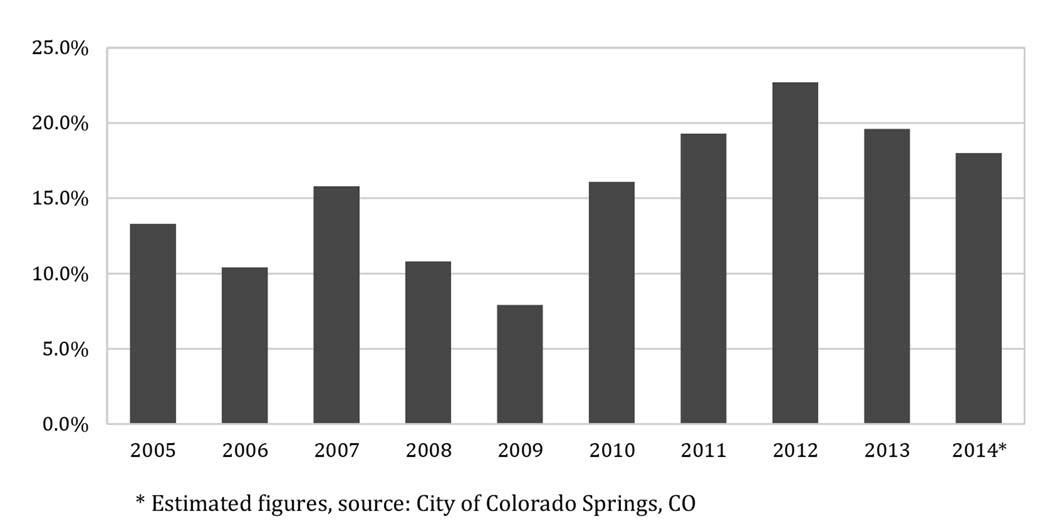
7 minute read
Implementing a Risk-Based Reserve Strategy in Colorado Springs
By Elizabeth Fu, Government Finance Officers Association
The fall 2013 edition of Public Sector Digest featured an article on City of Colorado Springs, Colorado and its approach to analyzing reserves based on the City’s risk factors. The City wanted to maintain emergency reserves but also wanted to identify an amount to reserve that was specific to its unique circumstances. Through working with the Government Finance Officers Association (GFOA) and Public Sector Digest, the City identified target reserve levels as well as ways to help support its overall reserve strategy.
Advertisement
Much has happened in the two years since the initial analysis, and this article provides a review of the initial risk-based reserve analysis as well as an update on Colorado Springs. The article will discuss the City’s reserve levels today, how the reserves have been used, and its overall approach to risk analyses.
I. The Analysis
In 2011, the City started to discuss how much it should maintain in reserves. General standards were considered, such as the GFOA’s best practice of maintaining no less than two months (16 percent) of regular general fund operating revenues or regular general fund operating expenditures in “unrestricted” fund balance1 in the City’s general fund.2 Colorado Springs hoped to find a dollar figure tailored to its own unique circumstances. The City was sensitive to the argument that while reserves provide a government with the ability to respond to and buffer against uncertainty and risk, excessive reserves could be used alternatively for additional services or could be returned to citizens, e.g. through lower taxes. The City worked with GFOA to determine how much it should maintain in reserves based on these considerations. GFOA conducted a review of the risk factors that generally influence the amount of reserves a municipal government should hold.3 A risk is defined as the probability and magnitude of a loss, disaster, or other undesirable event.4 Working with the City, these risk factors were then classified as primary or secondary. GFOA then analyzed the City’s level of exposure to these risks in order to calculate a customized target reserve level for the City’s general fund. The results of the analysis recommended approximately $54 million or 25 percent of the 2012 budget’s general fund revenues dedicated to reserves, specifically $27 million dedicated as a budgetary uncertainty reserve and $27 million as an emergency reserve.
Budget Uncertainty Reserve
$13 million for sales tax economic uncertainty + $7.5 million for economic uncertainty in other revenues + $6.25 million for pension payment uncertainty
=$27 million or about 12.5% of general fund revenues*
Emergency Reserve
$16.85 million for critical infrastructure needs ($5.25 million for critical bridge failure and $11.6 million for critical storm sewer replacement) + $5-7 million for extreme events
+ $2-4 million for expenditures spikes from lawsuits
=$27 million or about 12.5% of general fund revenues*
*Based on Colorado Springs’ 2012 budget
II. Implementing the Reserve Strategy
When the City presented the recommended target to the Mayor and city council, it was well received. This was in large part due to the transparent research-based assessment of Colorado Springs’ risks. The Mayor became a champion for meeting the reserve target level and the City became committed to achieving the reserve target of 25 percent of general fund expenditures to use as a hedge against its risks.
That year, the City set aside an amount equal to approximately 19.3 percent of its general fund expenditures in reserves. In 2012, the City’s “unrestricted” fund balance reached 22.7 percent. This is compared to between 7.9 percent and 15.8 percent that Colorado Springs previously recorded between 2005 and 2010 in its unreserved fund balance –resources that do not have any external legal restrictions or constraints for appropriation purposes.5
General Fund Reserve as Percentage of General Fund Expenditures (2005-2014)
* Estimated figures, source: City of Colorado Springs, CO


The reserves also proved to be prudent. After GFOA conducted its analysis, the City experienced two wildfires, one of which created flooding issues and furthered the deterioration of the City’s storm water infrastructure. Because Colorado Springs’ reserves had reached over 20 percent, it was able to tap into reserve funds to help pay for the storm water infrastructure replacement. For Colorado Springs, these events only furthered commitment to the target reserve level. Today, Colorado Springs still maintains a strong reserve – 19.6 percent of general fund expenditures for 2013 and an estimated 18.0 percent for 2014. While its reserve levels are below its target of 25 percent, the City wisely drew from the reserve funds as the unpredictable events dictated. Understanding the importance of reserves, the City is working towards replenishing the reserve fund from the draws.
III. Maintaining the Reserves
While the framework for GFOA’s analysis primarily focuses on risk retention, or using reserves to manage risk, it also encouraged the City to think about other risk management methods. GFOA identified strategies such as enhanced sales tax monitoring and development of an infrastructure maintenance/replacement schedule, as well as policies on user fee cost recovery, volatile revenue, short-term borrowing, and grants as mechanisms to help support the City’s overall general fund reserve policy. Colorado Springs has implemented some of these risk management strategies. The clearest example is the City’s approach to capital assets. Prior to the analysis, the most recent review of its capital improvement plan was in 2007-2008. After the analysis, Colorado Springs took a more comprehensive and forward-looking approach. The City reviewed its infrastructure needs and what could be funded. It then involved stakeholders and the public to prioritize the City’s needs, unconstrained by funding availability. The result of this process was the release of Colorado Springs’ five-year funded prioritized capital improvement plan in 2013. The plan includes anticipated needs over a five-year period as well as a tenyear period.
As part of the City’s recent capital improvement planning process, Colorado Springs also adopted strategies to help alleviate the need to retain risk. For example, from the financing perspective, the City is developing funding strategies to address the backlog of capital needs. It is also considering ways to reduce long-term maintenance and operating cost through low-impact, low-energy approaches to renovations and infrastructure development. Ask Colorado Springs what impact the reserve analysis has had on the City and the answer is greater focus on risk in general. The report got the City to look more holistically at risk. Recently, when approaching a decision to outsource

its fleet services, the City weighed the proposals to maintain the operations in-house or have a contractor manage the operations. If the operations were outsourced, what might that look like? The City al ready had the capital investment–facility, tools, and assets. Looking at these factors, the City opted to outsource the operations, but to maintain ownership of its assets should it need to bring the operations in-house.
IV. Lessons Learned
According to the City’s Chief Financial Officer, Kara Skinner, the reserves are higher than they would have been if it had not been for the risk-based analysis. The City thinks about risk from a more holistic perspective than before. This, of course, is aided by the City leadership’s focus on hedging against uncertainty. That is not to say that the conversations have stopped on whether the City holds too much in reserves, but the Mayor remains resolved because of the systematic analysis conducted on Colorado Springs’ risks.
Risk-based analyses are not meant to be static pictures. Colorado Springs understands this. Recently, the City had a ballot measure for creating a dedicated funding source for storm water. Even before voters went to the polls, the City was considering what risks were involved. Though the ballot measure did not succeed, if it had then the City would consider the revenue’s volatility and how that may impact its broader capital asset plan. Policy changes such as these may necessitate an updated riskbased analysis.
There are uncertainties and risks for which a government may consistently be susceptible to, but with policy changes and dynamic growth come new vulnerabilities. How a government reacts or is prepared to act is what is most important.
Elizabeth Fu is a Consultant at the Research and Consulting Center of the Government Finance Officer Association. Elizabeth works on projects related to longterm financial planning as well as risk-based reserve analyses. She would like to thank the City of Colorado Springs, CO, including Kara Skinner, Chief Financial Officer, for assisting with the article.
This article is reprinted with permission from the January 2015 issue of Public Sector Digest.











